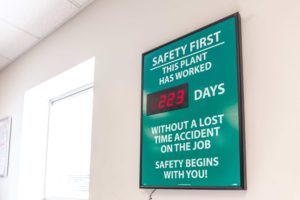What does “Zero Accidents” mean and why is it important to a company?
Simply stated it means “No Accidents”. Seems simple enough to describe but it gets a little more complicated when we think about how to achieve it.
The first thing we need to do is identify the causes of accidents or other “Loss Potentials”. We also have to know what a Loss Potential is. The easy definition is “Any unplanned event with an unplanned outcome”. It is something that we or our employees did not plan to happen and the results of the event were outside of our control. Notice that a Loss Potential does not require an injury to occur.
In 1931 H.W. Heinrich theorized that for every 300 Near Miss Incidents (no injury involved), there will be 29 minor injuries and 1 serious injury or fatality. This holds true in today’s work environment. He further determined that if a company only concentrates or reacts to those incidents that cause physical injury, a contractor will ignore 90+% of all accidents that occur on a job site. By paying attention to those 300 Near Miss Incidents we can learn how to reduce Loss Potentials and accidents.
When we look at Los Potentials we can identify two main areas. The first is Unsafe Conditions and the second is Unsafe Acts. Typically around 10% of all accidents or Loss Potentials are caused as a result of Unsafe Conditions on the job site. That leaves approximately 90% of all incidents are a result of Unsafe Acts on the job sites. Both of these items are tied to YOUR Safety Plan. Both Unsafe Conditions and Unsafe Acts reflect and inadequate Safety Plan or a Safety Plan that is not followed.
When you look at your Safety Plan closely you will note symptoms of Loss Potentials on your job site. These symptoms could include:
- Violations of Regulations
- Near Miss Incidents
- Accidents
- Injuries
You should be asking yourself “Why are these things happening?”
We find these things are happening because people (we) make choices on a daily basis that affect themselves and all others. Choices are usually based on past experience and acceptable risk. An acceptable risk to me is different than an acceptable risk to you. Example: An Ironworker performs his/her job at high elevations and that is part of their acceptable risk while others may be terrified of heights and there is absolutely no way they would work above the ground, it is not an acceptable risk to them. Some workers cannot deal with confined spaces while others feel exposed if they are not in a confined area. Based on these ideas choices are made, good or bad. To make good choices employees must have the knowledge to make the correct choice
In other words, do we make a choice because “I want to and it is the right thing to do”, or do I make the choice because “I am required to”? “I want to be safe” versus “I have to be safe”. If the choice is based on the right thing to do, the results will be better. Education provides knowledge for making good choices.
In order to understand choice, you have to understand what choices are. That is where education comes into play. Education promotes a belief that safe work sites should be expected the same way a baseball team believes that they can win the game before they even play it. If believing a job site should be and will be safe is not realized then workers tend to take chances that compromise their safety and the safety of all those around them. If believing turns into expectation (if we all believe it), workers will report for work expecting a safe work site and take more responsibility for their own actions and help those around them.
The benefits of Zero Accidents include but are not limited to:
- Reduction in Insurance costs:
- Becoming more competitive through lower operating cost:
- Being more efficient because our experienced workers are not missing time due to injuries or our equipment does not require needless repairs:
- Increases Moral on the job site. A happy crew tends to be a more productive crew.
A Zero Injury approach is a good business choice. It will only strengthen a company and make a better work place for those people that depend on the job to support their families. For the individual worker in the field, your family gets their father/mother/brother/sister home in the same condition they went to work only with more money in their pockets.
 763.417.9599
763.417.9599
